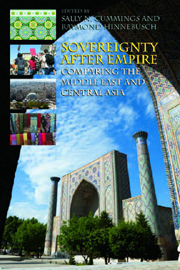Book contents
- Frontmatter
- Contents
- Acknowledgments
- Notes on the Contributors
- 1 Introduction
- SECTION I Histories of Empire and After
- SECTION II Paths to Sovereignty: Views from the Core and Periphery
- SECTION III Empire and Domestic Sovereignty
- SECTION IV Empire and Popular Sovereignty
- SECTION V Empire and External Sovereignty
- 13 Empire and State formation: Contrary Tangents in Jordan and Syria
- 14 Rentierism, Dependency and Sovereignty in Central Asia
- 15 Tajikistan: From de facto Colony to Sovereign Dependency
- 16 Conclusions
- Bibliography
- Index
16 - Conclusions
from SECTION V - Empire and External Sovereignty
Published online by Cambridge University Press: 12 September 2012
- Frontmatter
- Contents
- Acknowledgments
- Notes on the Contributors
- 1 Introduction
- SECTION I Histories of Empire and After
- SECTION II Paths to Sovereignty: Views from the Core and Periphery
- SECTION III Empire and Domestic Sovereignty
- SECTION IV Empire and Popular Sovereignty
- SECTION V Empire and External Sovereignty
- 13 Empire and State formation: Contrary Tangents in Jordan and Syria
- 14 Rentierism, Dependency and Sovereignty in Central Asia
- 15 Tajikistan: From de facto Colony to Sovereign Dependency
- 16 Conclusions
- Bibliography
- Index
Summary
This volume has argued that empire matters for post-imperial outcomes. In the introduction we observed that the similarity in the imperial creation of states in the Middle East and North Africa (MENA) and Central Asia (CA) seemed to explain similarities in the successor states. We also hypothesized that differences in imperial heritages explain the greater instability of the MENA states system and the lesser legitimacy of informal hegemony over that region compared with CA. Here, in the conclusion, we review the evidence and incorporate the findings of the chapter studies regarding these issues. We view the impact of empire on post-imperial sovereignty as mediated through intervening variables and, hence, organize the evidence under these categories: we examine effects of the drivers of transition from empire; we then summarize the evidence on the imperial transmissions left behind by empires. We then examine the extent of rupture after empire, with its implications for post-imperial hegemonies. We end with a summary of the outcome for the various dimensions of sovereignty, highlighting the similarities and differences between the cases.
Drivers of Transition and Post-imperial Outcome
Differences in post-imperial states and states systems could be expected to be partly a function of differences in the drivers of sovereignty, that is, the forces propelling the transition from empire to sovereignty. Decolonization is driven by both external forces (such as the international system) and internal forces (nationalist mobilization), which together shape the particular direction it takes.
- Type
- Chapter
- Information
- Sovereignty after EmpireComparing the Middle East and Central Asia, pp. 326 - 345Publisher: Edinburgh University PressPrint publication year: 2011



